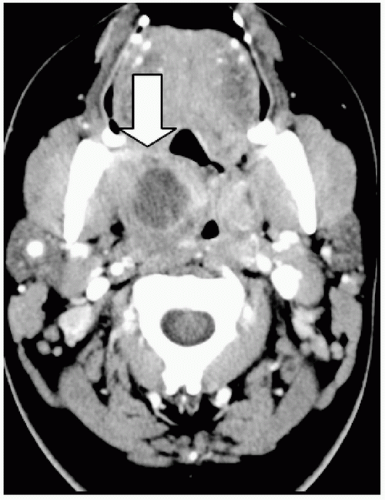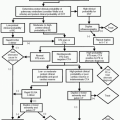Head and Neck Infections
Hari Charan P. Reddy
Oleg M. Teytelboym
Etiology and Presentation.
Tonsillar abscess most commonly occurs in adolescents or young adults, typically beginning as acute tonsillitis. Clinical presentation usually includes sore throat, dysphasia, fever, and cervical adenopathy. Progression of symptoms despite antibiotic therapy suggests development of an abscess. Acute tonsillitis can be treated with antibiotics; however an abscess should be treated with needle aspiration and or surgical drainage.
Complications.
Tonsillar infection is typically confined to the pharyngeal mucosal space by the middle layer of the deep cervical fascia; however the infection can spread to adjacent parapharyngeal or masticator spaces causing parapharyngeal abscess. Bilateral tonsillar abscesses can cause airway obstruction.
Possible Findings (Fig. 10-1)
Contrast-enhanced computed tomography (CT)
Enlarged tonsil with low density in the tonsil or peritonsillar regions with peripheral enhancement.
Edema and stranding of adjacent fat.
Enlarged cervical lymph nodes.
Magnetic resonance imaging (MRI)
Enlarged tonsil with peripheral enhancement.
High T2 and low T1 central signal.
Pitfalls
Important to differentiate from tonsillitis or phlegmon which present with tonsillar enlargement and edema without well-defined central fluid collection.
Etiology and Presentation.
True retropharyngeal abscess is rare. Most of the retropharyngeal space infections represent adenitis, suppurative adenitis, or phlegmon which can however progress to true abscess. There is usually an infection (i.e., pharyngitis, tonsillitis, adenitis, sinusitis, otitis) that spreads to the retropharyngeal nodes. Common organisms include Staphylococcus, Streptococcus, anaerobes, and tuberculosis. Infection can also spread directly from an adjacent space such as the parapharyngeal, submandibular, or prevertebral spaces or from direct inoculation through instrumentation or penetrating trauma/foreign body. Symptoms are variable depending on the age of the patient. Infants show neck swelling (97%), fever (85%), poor oral intake (55%), rhinorrhea, lethargy, and cough. Children older than 1 year can present with sore throat (84%), fever, neck stiffness, odynophagia, and cough. Adults demonstrate sore throat, fever, odynophagia, dysphagia, neck pain, and dyspnea. Inspection of the pharynx will show redness and edema. Treatment of retropharyngeal abscess usually requires surgical drainage.





